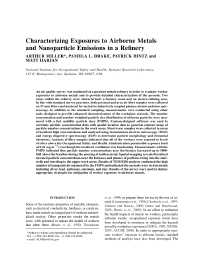Mining Publication: Characterizing Exposures to Airborne Metals and Nanoparticle Emissions in a Refinery
Original creation date: July 2010
An air quality survey was conducted at a precious metals refinery in order to evaluate worker exposures to airborne metals and to provide detailed characterization of the aerosols. Two areas within the refinery were characterized: a furnace room and an electro-refining area. In line with standard survey practices, both personal and area air filter samples were collected on 37-mm filters and analyzed for metals by inductively coupled plasma-atomic emission spectroscopy. In addition to the standard sampling, measurements were conducted using other tools, designed to provide enhanced characterization of the workplace aerosols. The number concentration and number-weighted particle size distribution of airborne particles were measured with a fast mobility particle sizer (FMPS). Custom-designed software was used to correlate particle concentration data with spatial location data to generate contour maps of particle number concentrations in the work areas. Short-term samples were collected in areas of localized high concentrations and analyzed using transmission electron microscopy (TEM) and energy dispersive spectroscopy (EDS) to determine particle morphology and elemental chemistry. Analysis of filter samples indicated that all of the workers were exposed to levels of silver above the Occupational Safety and Health Administration permissible exposure limit of 0.01 mg m-3 even though the localized ventilation was functioning. Measurements with the FMPS indicated that particle number concentrations near the furnace increased up to 1000-fold above the baseline during the pouring of molten metal. Spatial mapping revealed localized elevated particle concentrations near the furnaces and plumes of particles rising into the stairwells and traveling to the upper work areas. Results of TEM/EDS analyses confirmed the high number of nanoparticles measured by the FMPS and indicated the aerosols were rich in metals including silver, lead, antimony, selenium, and zinc. Results of the survey were used to deduce appropriate strategies for mitigation of worker exposure to airborne metals.
Authors: AL Miller, PL Drake, PJ Hintz, MC Habjan
Peer Reviewed Journal Article - July 2010
NIOSHTIC2 Number: 20036745
Ann Occup Hyg 2010 Jul; 54(5):504-513
See Also
- Bag and Belt Cleaner Reduces Employee Dust Exposure
- Comparing Measurements of Carbon in Diesel Exhaust Aerosols Using the Aethalometer, NIOSH Method 5040, and SMPS
- Effects of Diesel Exhaust Aftertreatment Devices on Concentrations and Size Distribution of Aerosols in Underground Mine Air
- A Handheld Electrostatic Precipitator for Sampling Airborne Particles and Nanoparticles
- In-depth Survey Report: Control Technology for Environmental Enclosures - The Effect of Wind Speed Upon Aerosol Penetration Into an Enclosure at Clean Air Filter, Defiance, IA
- Mine Aerosol Measurement
- Modified Tail Section Reduces Noise on a Continuous Mining Machine
- Noise Source Identification on a Continuous Mining Machine
- Particulate Penetration of Porous Foam Used as a Low Flow Rate Respirable Dust Size Classifier
- Role of Lubrication Oil in Particulate Emissions from a Hydrogen-Powered Internal Combustion Engine
- Content source: National Institute for Occupational Safety and Health, Mining Program


 ShareCompartir
ShareCompartir
